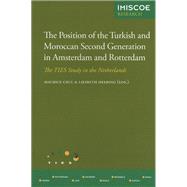
Maurice Crul is a senior researcher at the Institute for Migration and Ethnic Studies at the University of Amsterdam. Liesbeth Heering is researcher at the Netherlands Interdisciplinary Demographic Institute of the Royal Netherlands Academy of Arts and Sciences.
| Preface | p. 9 |
| Acknowledgements | p. 11 |
| List of tables | p. 13 |
| Introduction | p. 19 |
| The Ties project | p. 19 |
| Theoretical and methodological backgrounds | p. 21 |
| The Ties project in the Netherlands | p. 23 |
| Migration history and demographic characteristics of the two second-generation groups | p. 27 |
| Introduction | p. 27 |
| Immigration trends and migration policy: a brief historic overview | p. 27 |
| People of Turkish and Moroccan descent in Amsterdam and Rotterdam | p. 31 |
| Demographic characteristics of the second generation in the TIES survey | p. 34 |
| Demographic characteristics of the second generation | p. 34 |
| Demographic characteristics of the parents | p. 36 |
| Demographic characteristics of the siblings | p. 42 |
| Household size and position | p. 43 |
| Conclusions | p. 45 |
| Housing and segregation | p. 49 |
| Introduction | p. 49 |
| Housing situation | p. 49 |
| Concentration and segregation | p. 52 |
| Housing policies | p. 54 |
| Housing situation of the second generation | p. 56 |
| Conclusions | p. 62 |
| Education | p. 63 |
| Introduction | p. 63 |
| The educational system in the Netherlands | p. 63 |
| Educational priority policies in the Netherlands | p. 65 |
| Overview of the educational position of pupils and students of Moroccan and Turkish descent | p. 66 |
| Ties respondents: entry into school | p. 67 |
| Primary education | p. 68 |
| Secondary education | p. 72 |
| Experiences at school | p. 77 |
| The parental home and education | p. 80 |
| Conclusions | p. 84 |
| Labour and income | p. 87 |
| Introduction | p. 87 |
| Ethnic minorities in labour market policies | p. 87 |
| The labour market position of Turks and Moroccans in Amsterdam and Rotterdam | p. 90 |
| Labour market position of the three study groups in the Ties survey | p. 91 |
| Income position of the three ethnic groups in the TIES survey | p. 97 |
| Discrimination on the labour market | p. 99 |
| Conclusions | p. 102 |
| Identities and intercultural relations | p. 105 |
| Introduction | p. 105 |
| Dutch context of identity and intercultural relations | p. 106 |
| Indicators of identity | p. 108 |
| Language proficiency and use | p. 112 |
| Religion | p. 113 |
| Affiliation with religion | p. 113 |
| Religiosity | p. 114 |
| Transnationalism | p. 119 |
| Intercultural relations | p. 120 |
| Preferred norms and values | p. 120 |
| Views on the multicultural society | p. 121 |
| Views on members of other ethnic and social groups | p. 123 |
| Conclusions | p. 124 |
| Social relations | p. 129 |
| Introduction | p. 129 |
| Ethnic character of friendships in secondary school and at present | p. 129 |
| Participation in and ethnic orientation of social organisations | p. 132 |
| Perceptions on personal and group discrimination | p. 134 |
| Conclusions | p. 140 |
| Union and family formation | p. 143 |
| Introduction | p. 143 |
| The context of union and family formation among immigrants | p. 143 |
| Union formation among the TIES respondents: timing and type of current relationships | p. 145 |
| Meeting places and family influence | p. 148 |
| Partner choice: partner characteristics | p. 149 |
| Family formation | p. 153 |
| Task division | p. 154 |
| Conclusions | p. 158 |
| Conclusions and implications | p. 161 |
| Study implications | p. 165 |
| Sample design, Ties survey implementation and evaluation | p. 169 |
| Sample design | p. 169 |
| Ties survey implementation | p. 175 |
| Ties survey evaluation | p. 176 |
| Conclusies en aanbevelingen | p. 181 |
| List of contributors | p. 189 |
| Table of Contents provided by Ingram. All Rights Reserved. |
The New copy of this book will include any supplemental materials advertised. Please check the title of the book to determine if it should include any access cards, study guides, lab manuals, CDs, etc.
The Used, Rental and eBook copies of this book are not guaranteed to include any supplemental materials. Typically, only the book itself is included. This is true even if the title states it includes any access cards, study guides, lab manuals, CDs, etc.